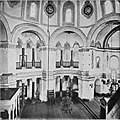Sió Hagia Sophia
| Sió Hagia Sophia tshing-tsin-sī (Küçük Ayasofya Camii) | |
|---|---|
 Northeast (áu-phiah) view of Little Hagia Sophia in 2013 | |
| Chong-kàu | |
| Chong-kàu |
Sunni Islam (bo̍ktsên); Greek Orthodox (original) |
| khai-kong nî |
between 1506 and 1513 (Islam); c. 536 (Christianity) |
| Só͘-chāi | |
| Só͘-chāi | Türkiye İstanbul |
| Kiàn-tio̍k | |
| Kiàn-tio̍k-su | Isidorus of Miletus, Anthemius of Tralles (attributed) |
| Lūi-hêng | kàu-tn̂g |
| Hong-keh | Byzantine |
| Chhòng-sin | 532 |
| Oân-kang | 536 |
| Siông-chêng | |
| Minaret | 1 |
| Châi-liāu | |
| Part of | Historic Areas of Istanbul |
| Criteria | Cultural: i, ii, iii, iv |
| Reference | 356 |
| Inscription | 1985 (Tē-9 session) |
Sió Hagia Sophia tshing-tsin-sī (kàu-tn̂g) (ing-gú: Little Hagia Sophia Mosque; türk-gú: Küçük Ayasofya Camii), guân-lâi sī Saints Sergius hām Bacchus kàu-tn̂g (Hellēnikḗ-gú: Ἐκκλησία τῶν Ἁγίων Σεργίου καὶ Βάκχου ἐν τοῖς Ὁρμίσδου, Ekklēsía tôn Hagíōn Sergíou kaì Bákchou en toîs Hormísdou), sī tsi̍t-king khah-tsá sī Elláda tang-tsìng-kàu kàu-tn̂g, kiong-hōng Constantinople ê Saints Sergius and Bacchus, kiàn-li̍p tī 532-nî tsì 536-nî tsi-kan, teh Osman tè-kok kî-kan kái-kiàn tsò Tshing-tsin-sī.[1]
Tsit-king kèn-iú tiong-iong îñ-tíng siat-kè ê Byzantine iūñ-sik kèn-tio̍k sī-iû Justinian tī 6 sè-kí sóo kiàn-tsō. Tō-sǹg-kóng i-ê Türkiye bîng-tshing, tsit-king kèn-tio̍k khó-lîng m̄ sī "Hagia Sophia tuā kàu-tn̂g" ("Sîn-sìng tì-huī") ê bôo-hîng, i-ê kèn-tio̍k kho-sī tong-tāi-ê; m̄-kù i iû-guân sī Istanbul siong tiōng-iàu ê tsá-kî Byzantine kèn-tio̍k tsi it.[2] Procopius tong-sî jīn-uî i sī kui-ê siâñ-tshī ê tsong-sik-phín,[3] tsi̍t-uī hēn-tāi Tang Lô-má tè-kok li̍k-sú ha̍k-ka án-ne siá tsit-king kàu-tn̂g: "Pîn-tsià i kiàn-tio̍k ê to̍k-tshong-sìng hām tiau-khik tsong-sik ê kik-hua-phùn, teh Constantinople kīn-tshù-î St Sophia pún-sin".[4]
Kèn-tiok ê ket-kòo
[siu-kái | kái goân-sí-bé]luē-pōo ê ket-kòo
[siu-kái | kái goân-sí-bé]-
Column detail and northern part of the dome.
-
Tóo-muh (îñ-hîng tshù-tíng).
-
Uē-lông.
-
Thiāu-á tsáu-lông
-
Interior north-west (1914).
-
Little Hagia Sophia exterior
-
Little Hagia Sophia view from graveyard in its back
-
Little Aya Sophia wide angle view
-
Little Hagia Sophia view from first floor
-
Little Hagia Sophia view from first floor
-
Little Hagia Sophia view from first floor
-
Little Hagia Sophia rim under first floor
-
Little Hagia Sophia column and rim under first floor
-
Little Hagia Sophia details from the interior
-
Little Hagia Sophia details from the interior
-
Little Hagia Sophia details from the interior
-
Little Hagia Sophia details from the interior
Tsù-kái
[siu-kái | kái goân-sí-bé]- ↑ Bardill, Jonathan (2017). "The Date, Dedication, and Design of Sts. Sergius and Bacchus in Constantinople". Journal of Late Antiquity (ēng Eng-gí). 10 (1): 85–86. doi:10.1353/jla.2017.0003. ISSN 1942-1273.
- ↑ Bardill, Jonathan (2017). "The Date, Dedication, and Design of Sts. Sergius and Bacchus in Constantinople". Journal of Late Antiquity (ēng Eng-gí). 10 (1): 62–130. doi:10.1353/jla.2017.0003. ISSN 1942-1273.
- ↑ Procopius, De Aedificiis, I.4.3–8. Procopius was describing both the Church of Saints Sergius and Bacchus and the conjoined Church of Saints Peter and Paul.
- ↑ Norwich (1988), p. 531
Tsham-khó bûn-hèn
[siu-kái | kái goân-sí-bé]- Bardill, Jonathan (2000). "The Church of Sts. Sergius and Bacchus in Constantinople and the Monophysite Refugees"[íng-íng bô-hāu ê liân-kiat], extract from Dumbarton Oaks Papers No. 54. Washington: Dumbarton Oaks Research Library and Collection.
- Bardill, Jonathan (2017). "The Date, Dedication, and Design of Sts. Sergius and Bacchus in Constantinople". Journal of Late Antiquity. 10 (1): 62–130. doi:10.1353/jla.2017.0003.
- Freely, John (2000). Blue Guide Istanbul. W. W. Norton & Company. ISBN 0-393-32014-6.
- Krautheimer, Richard (1986). Architettura paleocristiana e bizantina (ēng Í-tāi-lī-gí). Turin: Einaudi. ISBN 88-06-59261-0.
- Mango, Cyril (1975). Byzantine Architecture. New York: Harry N. Abrams, Inc. ISBN 0-8109-1004-7.
- Mango, Cyril (1972). "The church of Saints Sergius and Bacchus at Constantinople and the alleged tradition of octagonal palatine churches". Jahrbuch der österreichischen Byzantinistik. Vienna (21): 189–93.
- Mathews, Thomas F. (1976). The Byzantine Churches of Istanbul: A Photographic Survey. University Park: Pennsylvania State University Press. ISBN 0-271-01210-2.
- Müller-Wiener, Wolfgang (1977). Bildlexikon Zur Topographie Istanbuls: Byzantion, Konstantinupolis, Istanbul bis zum Beginn d. 17 Jh (ēng Tek-gí). Tübingen: Wasmuth. ISBN 978-3-8030-1022-3.
- Norwich, John Julius (1988). Byzantium: the early centuries. New York: Alfred A. Knopf. ISBN 0-394-53778-5.
- Van Millingen, Alexander (1912). Byzantine Churches of Constantinople. London: MacMillan & Co.
Ên-sin ua̍t-to̍k
[siu-kái | kái goân-sí-bé]- Weitzmann, Kurt, ed., Age of spirituality: late antique and early Christian art, third to seventh century, no. 249, 1979, Metropolitan Museum of Art, New York, ISBN 9780870991790; full text available online from The Metropolitan Museum of Art Libraries (Eng-gí)
Tsham-ua̍t
[siu-kái | kái goân-sí-bé]- Carl Gustaf Emil Mannerheim
- Heimosodat
- To̍k-li̍p Chiàn-cheng chheng-toaⁿ (To̍k-li̍p tsèn-tsing tshing-tuañ/List of wars of independence)
- Gôlôsu lîm-sî chèng-hú (Gôlôsu lîm-sî tsìng-hú/Russian Provisional Government)
- Mukden hōe-chiàn (Mukden huē-tsèn/Battle of Mukden)
Guā-pōo lên-ket
[siu-kái | kái goân-sí-bé]- Over 40 pictures of the mosque (Eng-gí)
|
- CS1 Í-tāi-lī-gí chu-liāu (it)
- CS1 Tek-gí chu-liāu (de)
- 6th-century churches
- Buildings of Justinian I
- Byzantine sacred architecture
- Mosque buildings with domes
- Fatih
- Historic sites in Turkey
- Mosques converted from churches in Istanbul
- Articles containing video clips
- World Heritage Sites in Turkey
- Church buildings with domes


















